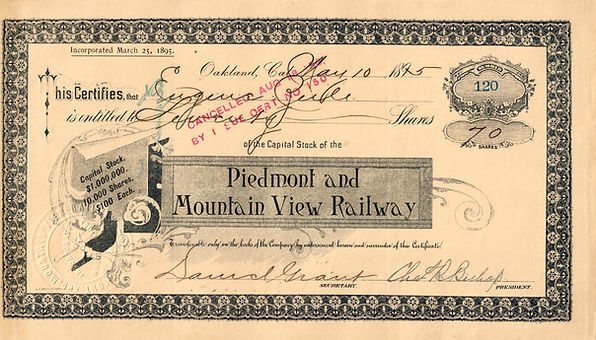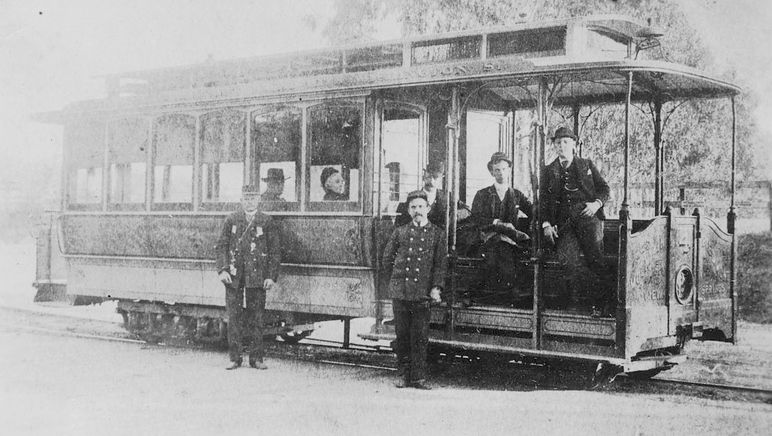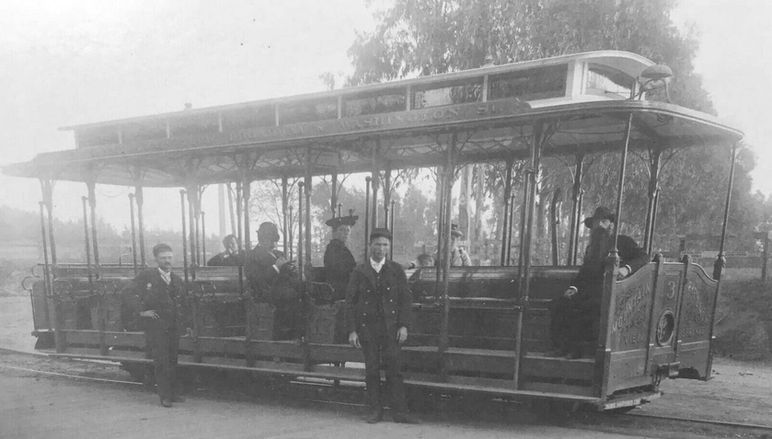Piedmont & Mountain View Railway
Piedmont & Mountain View Railway (electric), 1895 - 1897
The Western Railroader For the Western Railfan 1959-03: Vol 22 Iss 5:
PIEDMONT & MOUNTAIN VIEW RAILWAY CO.
During the spring of 1895, the cable road from Oakland to the Piedmont hills was converted to electricity. However, the electric cars would operate to Vernal Avenue (Highland Avenue) only, as the old loop running via Blair Park where the cable cars became gravity cars, was to be abandoned. The branch line to the Mt. View Cemetery was also converted to electricity. Cars would terminate at 7th and Washington Street in Oakland, and the original cable tracks being of narrow gauge, would be retained. The cable would still be used on the steep Oakland Avenue hills.
The converted cable to electric cars were equipped with two Thompson-Houston 15 h.p. motors mounted on one truck, the other truck retaining the cable grip. K controllers were used. The 11 motorized cars were numbered 110-120 inclusive, Nos. 119-120 were open cars. The trailers retained their original numbers, 12-22 inclusive. All of the Piedmont cars were painted yellow with black trim. In June, 1896, the Piedmont line was ready for electric operation and on June 10, 1896, the first car, No. 106, made the trial trip with a capacity load of paid passengers on each round trip.
The following day saw regular scheduled cars on the line. These were cars Nos. 106-109 inclusive. The West 14th Street line was extended to 7th and Washington Street at this time. In December, 1896, the grip was removed from each car and two W.P. 50 h.p. motors were mounted, one on each truck. At this time the Piedmont cars were painted blue, trimmed in gold gilt.
These two electric lines of the Piedmont & Mt. View Railway were operated very successfully until July 14, 1897, when the company was absorbed by the well known Realty Syndicate, with Ira Bishop as its general manager and superintendent.
Key System Streetcars: Transit, Real Estate and the Growth of the East Bay
Book by Vernon J. Sappers, 1990:
Piedmont & Mountain View Railway
This company was formed as a reorganization of the Consolidated Piedmont Cable Company, and upon consolidation acquired 20 cable cars.
The odd-numbered cars (1 to 19) were open carbodies, and even-numbered cars (2 to 20) were closed cars. The above cars were never electrified by this company, but after consolidation into the OTCO, they were converted into electric cars. The electric cars of this company, all built by the Hammond Company in 1893, are shown as follows:
Cars 101-105 were double-truck, and were equipped with one WP30 motor, rheostatic control, and had open fronts and hand brakes. Numbers 106-109 had one WP30 motor, type J control, and had open fronts and hand brakes. They became OT 135-144 (except P&MV 140, which became 1014, and P&MV 142, which became second 105), an example of the anomalies in the early roster.
There were scrapped as follows:
133 - April 1915 134, 135 - 1917
136 - July 1920 137, 138 - June 1916
139 - October 1918 141 - June 1916
143, 144 - October 1918


Key System Streetcars: Transit, Real Estate and the Growth of the East Bay, Book by Vernon J. Sappers, 1990:
Articles of incorporation were filed March 27, 1895. The only portion of the old company that was not acquired was the abandoned horse car line on Broadway north of Piedmont Avenue. Electrification was costly and the company was in poor financial condition, but in June 1895, the Piedmont Avenue line was converted with the exception of the loop through downtown Oakland, which was abandoned; the electric cars now terminated at 7th and Washington Streets. It was more difficult to convert the steep, hilly section and for a brief period the Oakland Avenue portion was cable-operated on weekends while downtown operated electrically. The gravity loop was discontinued. Finally all-electric operation began in December 1896. Some of the cable cars had been rebuilt into double-end California-type electric cars having blue and gray livery with gold lettering. Apparently after the cars were equipped with two motors, electric cars were able to carry light loads up the Oakland Avenue hill, though inclement weather and inadequate brake systems made such operation problematic, and it ceased under the succeeding Oakland Transit management. Eventually the steep grade on Oakland Avenue between Linda and Vernal (Highland) was abandoned in favor of a route with an easier grade from Piedmont Avenue via private right-of-way to Highland Avenue. Tracks were also laid on Linda Avenue including a short stretch of private right-of-way connecting Oakland and Piedmont Avenues.
The Piedmont & Mountain View was hurt financially by the Oakland Consolidated Street Railway's new competing electric line to the cemetery on Howe Street. Assessments were levied against stockholders, and even employees suffered; for gripmen, motormen and conductors was cut from 22 to 20 cents in August 1895.
Heron and Bishop were associates of F.M. Smith, who acquired the line on July 2, 1898 and merged it into his Oakland Transit operations.


The Oakland Transit Company was formed on March 1, 1898, to take over the Oakland Consolidated Street Railway Company, the Central Avenue Railway Company, the Alameda Oakland and Piedmont Electric Railroad Company, the Piedmont and Mountain View Railway Company (earlier name Consolidated Piedmont Cable Co.), the East Oakland Street Railway Company, the California Railway, and the Highland Park and Fruit Vale Railroad. In 1901, this company took over the Oakland Railroad which by now was a standard gauge electric system to form the Oakland Transit Consolidated. The Oakland Railroads lines were the Telegraph Avenue line, the San Pablo Avenue line, and the shuttle line on Alcatraz Avenue, between Lorin (south Berkeley) and Telegraph Avenue. This company had in 1899, built the first portion of the new defunct Euclid Avenue line in Berkeley, from Shattuck Square to Hilgard and Euclid Avenues. Better routing was now possible, and the standard gauged track along Shattuck was connected up with the Telegraph avenue line. Of course, at this time the gauge on Shattuck had been changed to standard gauge. At about the same time, the Grove Street trackage was rebuilt into a standard gauge line from 20th and San Pablo Avenue to Lorin. For sometime after this two narrow gauge cars were run on Grove street north from Lorin, to Berkeley station via Grove and Center Streets.











